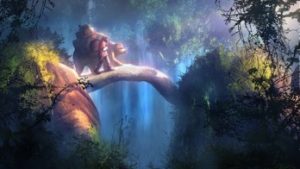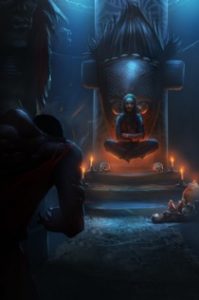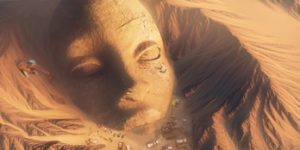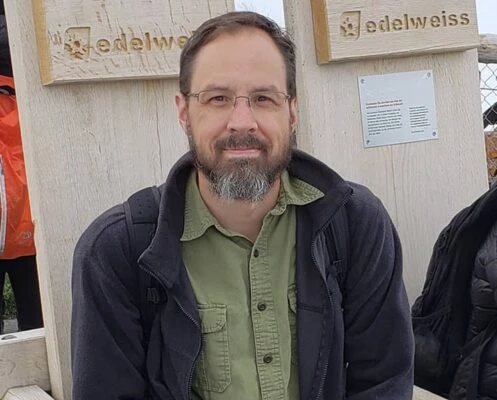
Self-taught digital artist Godwin Akpan’s work graces the cover of this month’s issue. Currently based in Lagos, Nigeria, Godwin works full time at Anthill Studios doing concept art and illustration.
APEX MAGAZINE: Your cover art for this month’s issue, “Playing with fire,” evokes the character’s sense of wonder and determination. What are the challenges of working with magical or fantastical images, yet keeping an emotional connection? Are some emotions easier, or more difficult, to show through art?
GODWIN AKPAN: It is often said that a picture is worth a thousand words. So, when I am creating my illustrations, I have to think like a writer. Whether I am creating characters or environment, I am constantly trying to think of the story surrounding the image I am creating. Regarding the challenges, there are a ton of them. A big one is the temptation to create something completely new—something no one has ever seen. While that is possible, it is not always the best course of action. You don’t ever want to alienate your audience, so while creating fantasy images, I always build upon what exists, so it is easily relatable. Instead of inventing a completely alien creature, why not take a common, recognizable animal and add your own little touch? For example, a unicorn: this is just a horse with a horn, but it’s still a fantastic concept.
Speaking of emotion, there are several ways of making your audience emotionally invested. The easiest way for me is using light and color. Certain color schemes evoke certain emotional responses. Whether I want the viewer to feel excitement, disgust, or anxiety determines the overall color scheme I choose. So, a dark hallway will definitely create anxiety for the viewer because people often put themselves into the situation that I am creating. As a way to further capture the viewers interest, I often use characters in my composition. That way, they connect emotionally to the story or idea that I am communicating through my works.
There are definitely some ideas or emotions that are harder to capture in a single image. The secret is spending some extra time thinking carefully about the subject, as opposed to just jumping into the painting. And that is what thumbnails are for; they allow you to explore a subject from different angles, so you can come up with something compelling in the end.
AM: With an image like “journey,” the viewer seems to be able to decide for themselves if the characters are just starting out on the journey or have been through a lot together already. Do you spend time, even on a single illustration, on what the story around the characters might be? If you don’t get detailed stories or information from a client, do you build ideas of what you personally think the characters or environment should be?

GA: Creating believable and relatable characters means spending lots of time thinking about the story surrounding the character. In some cases, I think of someone or somewhere I know that might fit the description of what I am currently working on. Then I try to match my design to that. That way, it is believable because it is referencing something in the real world. Sometimes I even use my own experiences as a source of inspiration to build on. While working on a client’s idea, I usually ask for as much information as possible, so I can get into the mind of the client. It can get really frustrating when a client doesn’t communicate their ideas properly, and then I create something they reject. So, I always try to avoid that by getting all the necessary information. Some clients only feature about a third of the input to be mine. But some clients like me to have full creative control, and only under such circumstances do I go all out with my ideas
AM: There’s a wonderful subtlety in a piece like “magic shop,” where you hint that the cultural and even darker aspects of the scene should be explored by the viewer. How does your audience typically react to those subtle clues, versus more overt scenes? In comments that you’ve received, do they explore your imagery and stories as much as you would like?

GA: One thing I like about people in general is that they all a have different way of seeing a subject. So, when I paint, I like to give room for the imagination. While I have a clear picture in my mind about what the story is, it’s also nice to hear people make their own interpretation of my works. Sometimes their version even sounds cooler. I’ve had comments on my works that highlighted things I probably didn’t give much thought to. And because most of my artworks have subject matters that don’t require a graduate degree to comprehend, many people usually find it easy to understand.
Obviously, there are times when I add subtle details that require extra attention to notice. But that isn’t always my aim. My aim is for viewers to understand what they are seeing and to come back for more.
AM: As a concept artist, where do you find the balance between adding your own imagery to a piece versus following guidelines more stringently? Do you usually have more or less freedom to add those touches while working with clients?
GA: As a concept artist, it can be quite challenging to follow strict guidelines from clients. Some clients may want me to adopt a different art style from the one I am comfortable with, which can be very frustrating. But because the client is paying, I guess I have to do whatever they want. As a general rule, though, after I get a brief, I do thumbnail variations for the client to decide. That way, I am able to apply the description from the client to the thumbnails, while adding my own taste to some other variations.
AM: Many of your pieces, such as “Lost Heritage,” feature vast differences in scale between characters and their environment. Have you been (or would like to be) in similar situations in real life, away from art, that help you think of grand scales? Are you hoping that the viewer concentrates on the majesty of the massive environment, the small, intimate size of the character, or a bit of both?

GA: It can’t be said enough that I love mega structures. It’s funny because I haven’t actually been around the kind of epic-scale structures I put in my paintings. Every time I paint of one those, I always imagine myself in a similar place. I’m hoping that in the future, when I have more time on my hands, I’ll visit all the great places that have huge monuments, such as the sphinx and pyramids in Egypt, even the statue of liberty in New York City.
AM: Thank you to Godwin Akpan for an interesting look at his work. You can find more of his art on his ArtStation portfolio at coldflames.artstation.com.









